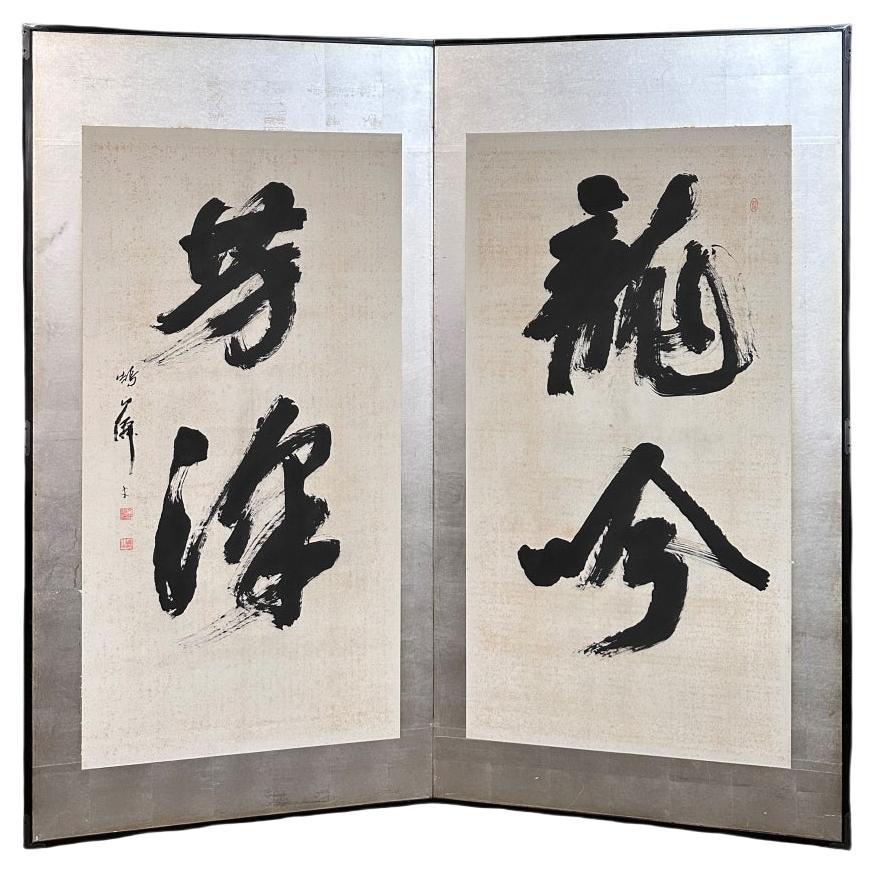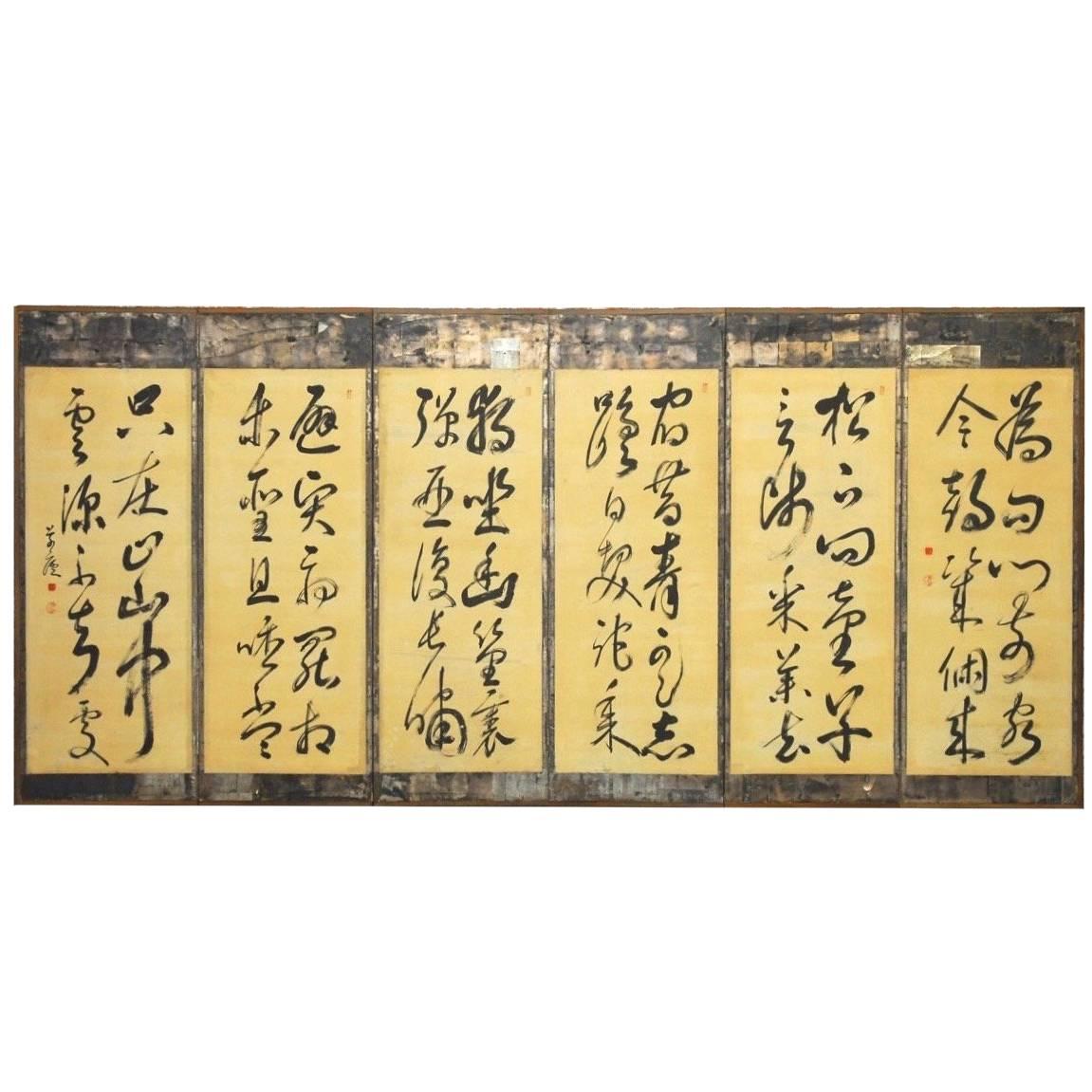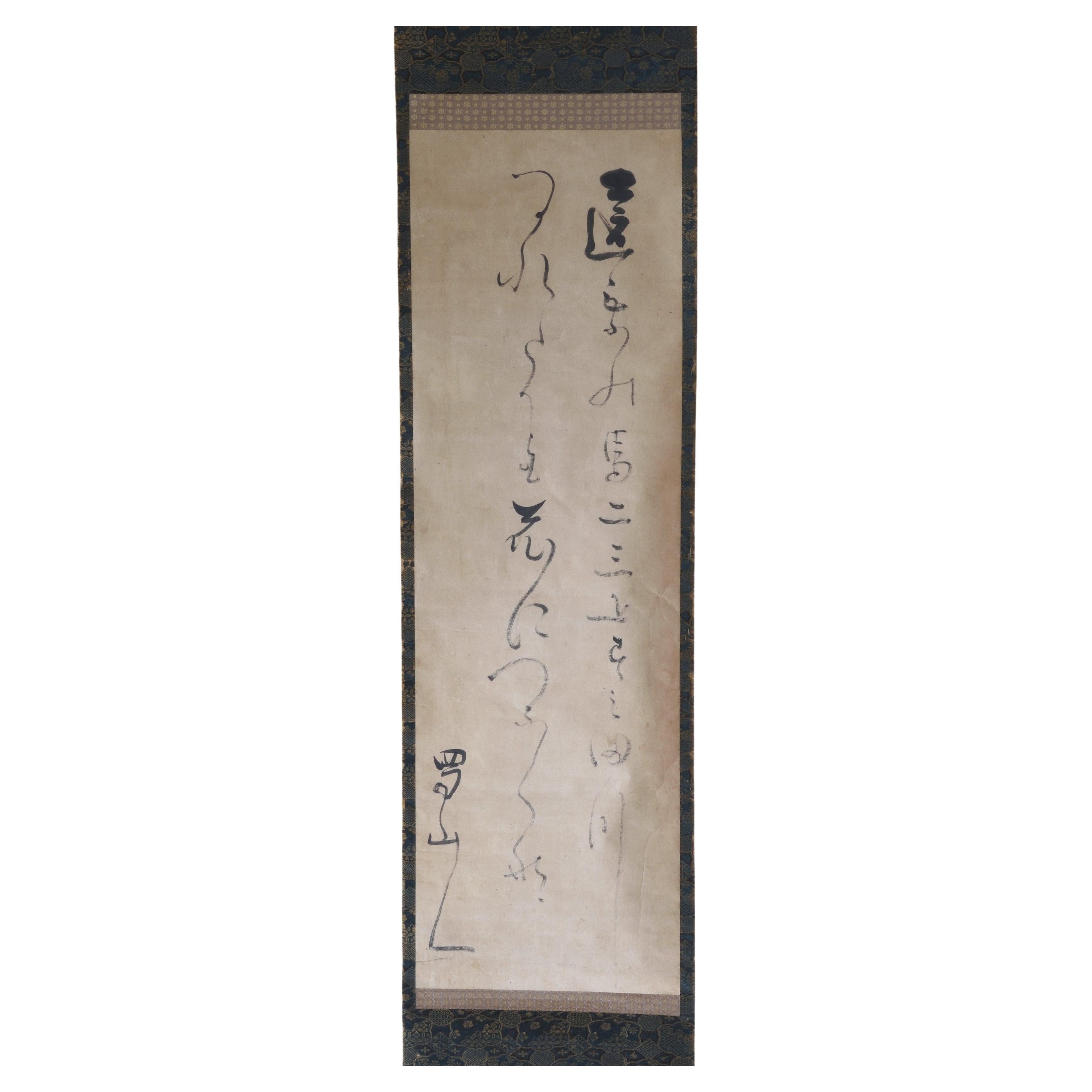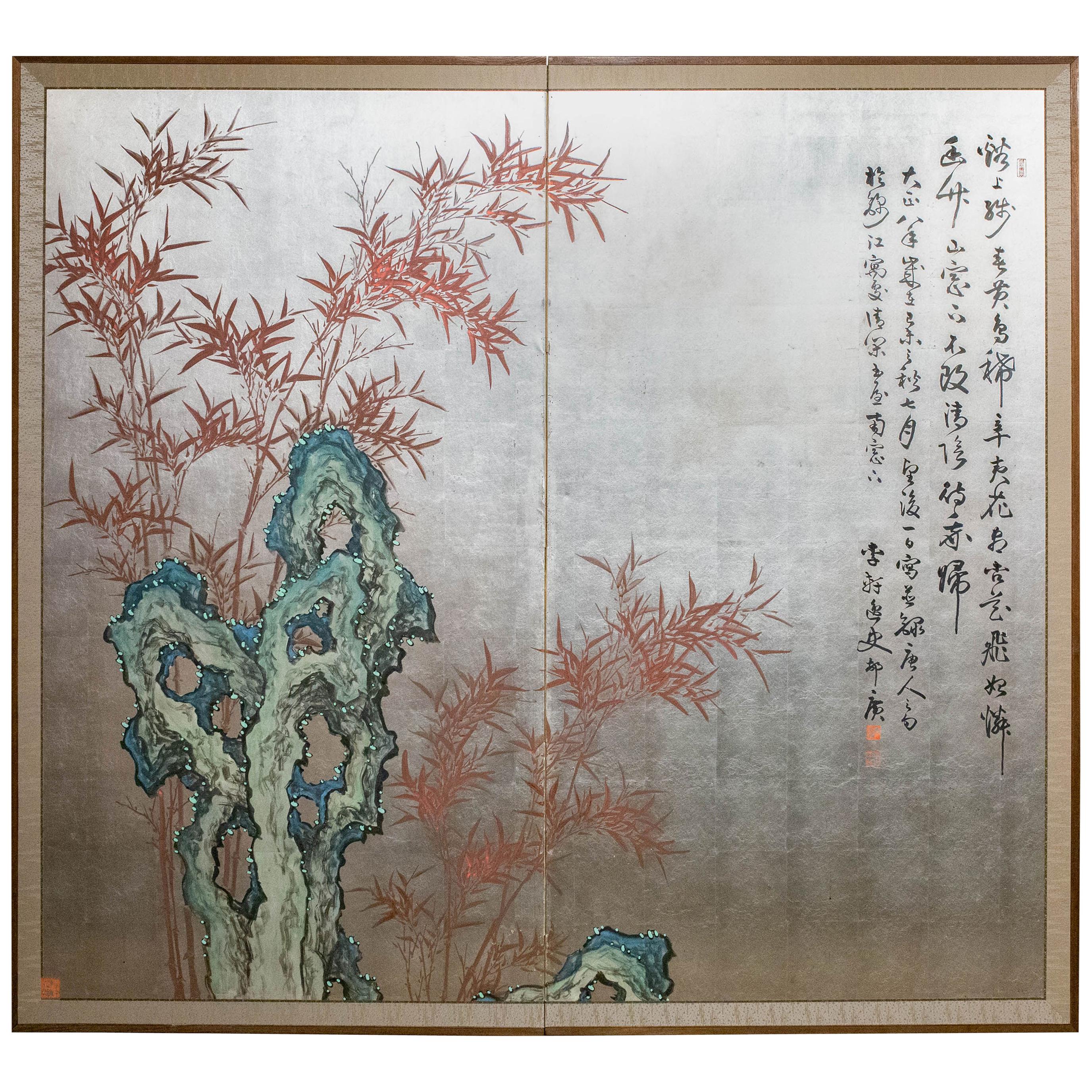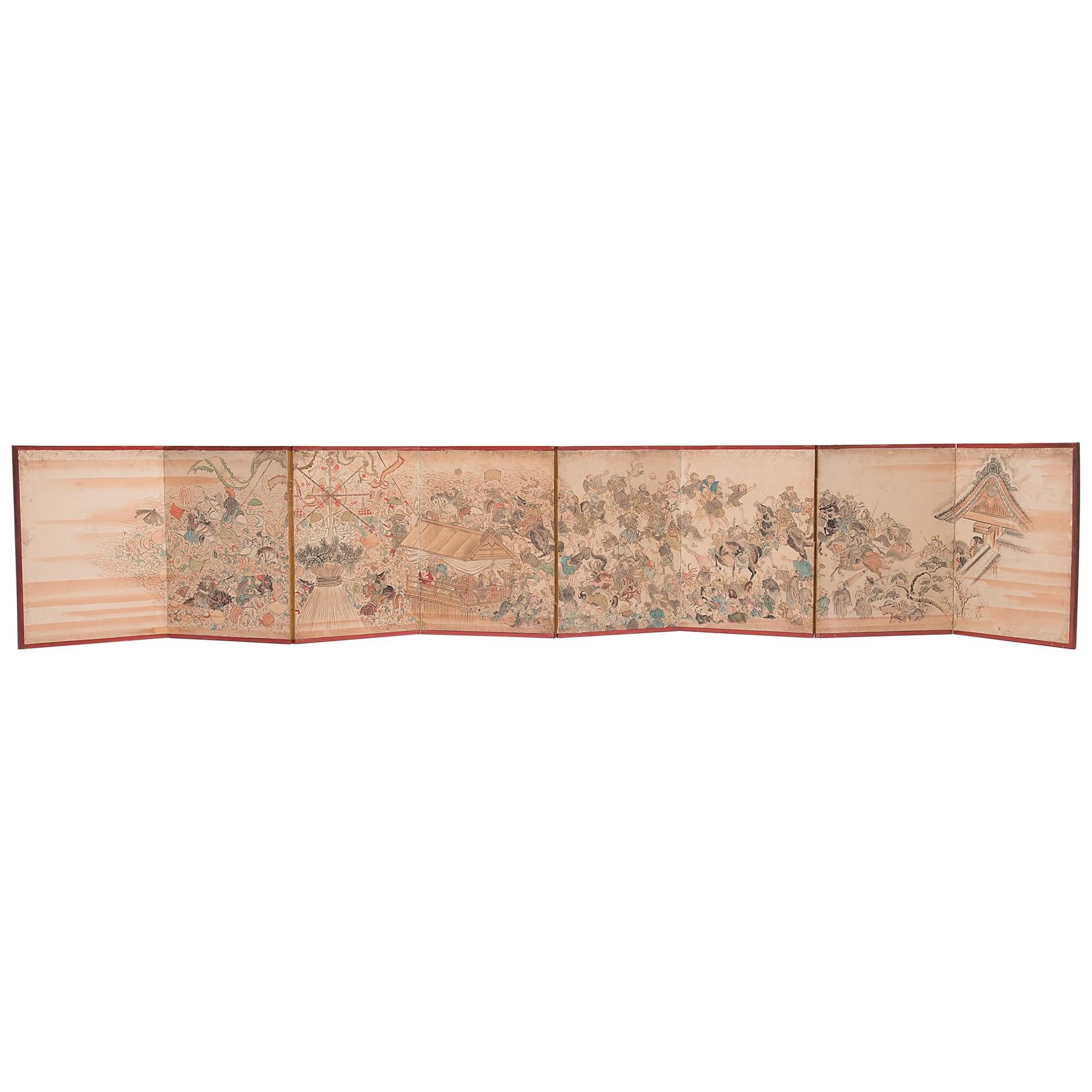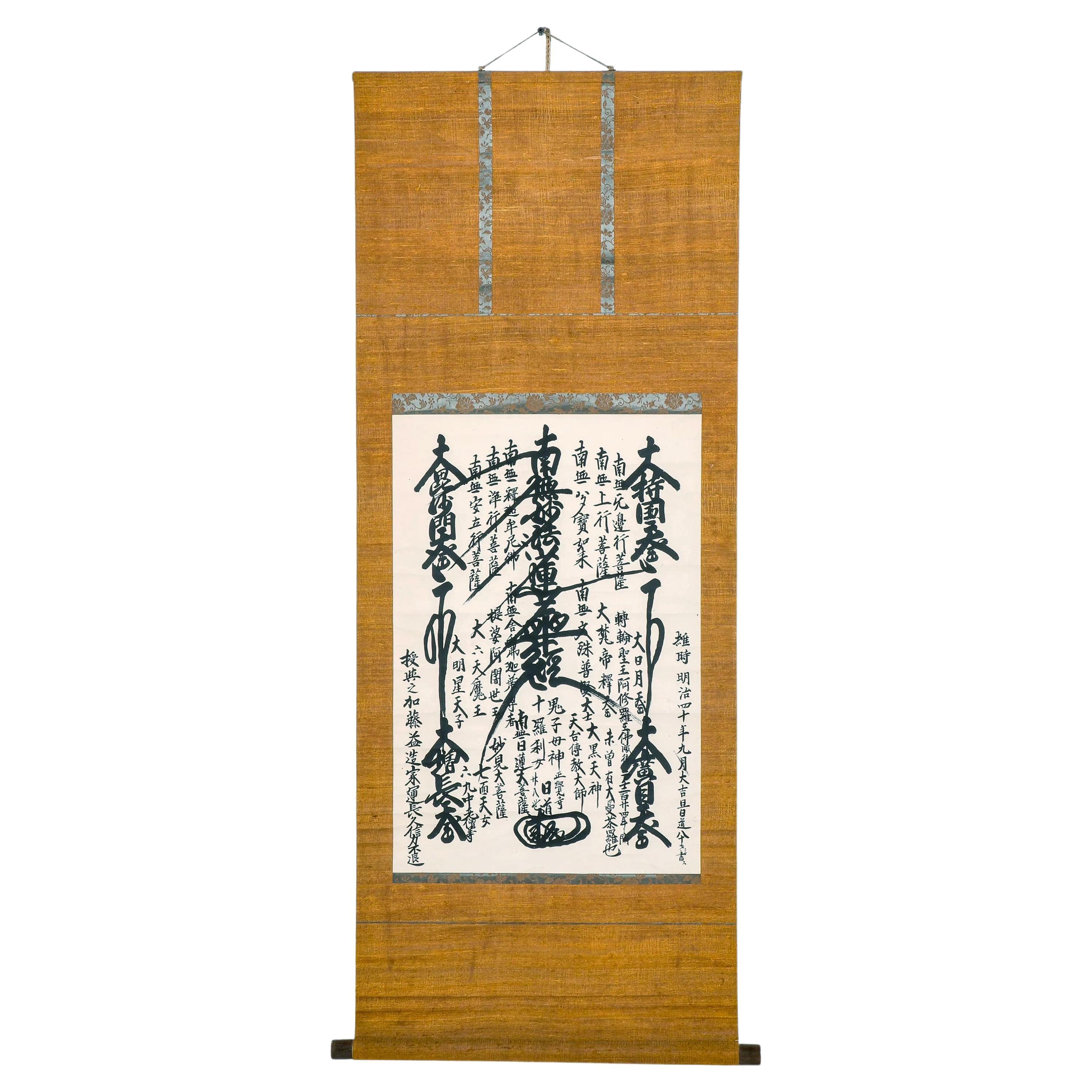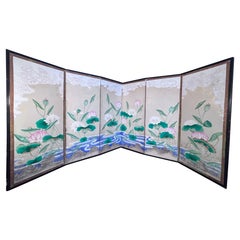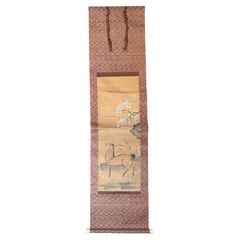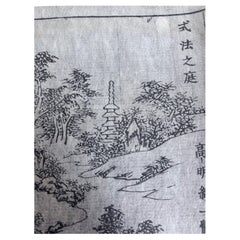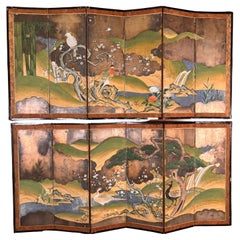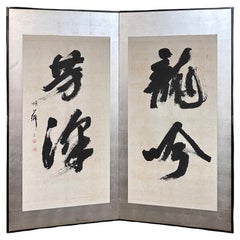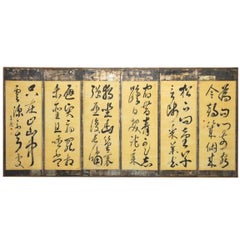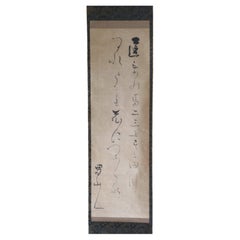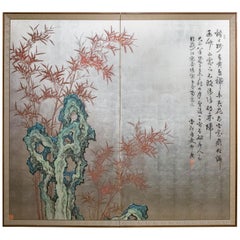Items Similar to Japanese Fine Antique Screen Hand Painted "Buddhist Nature" in Sumi Ink
Want more images or videos?
Request additional images or videos from the seller
1 of 14
Japanese Fine Antique Screen Hand Painted "Buddhist Nature" in Sumi Ink
$1,800
£1,374.29
€1,587.98
CA$2,526.86
A$2,816.45
CHF 1,477.69
MX$34,393.42
NOK 18,710.81
SEK 17,684.56
DKK 11,851.80
About the Item
From our recent Japanese Acquisition Travels
Praised as "the crown of poets from the eastern lands."
Japan, a good antique six-panel screen Byobu depicting hand painted on paper with bold strokes in Sumi Ink prose "Buddhist Nature" remarkable calligraphy in monumental form. This attractive screen dates to the middle edo to Meiji period,
Signed Kyokuso with red seals.
Six large scale panels of hand painting Clearly was a composition screen used and was a loving work of art.
Buddhist nature prose is an unusual motif for Japanese screens and we are pleased to have found this one on our last Japanese acquisitions travels.
It is simple yet beautifully painted with excellent ink and brush skill and masterful strokes.
Dimensions: 68 inches high and 137 inches wide extended.
Enticing and rare subject matter, this painting is skillfully and tastefully rendered in sumi ink paint pigments on paper against a cream flecked paper background. The original blue silk brocade border is present. An original black lacquered wood frame nicely compliments this serene and desirable composition. Please look at the photographs closely that reveal all of these fine hand painted details. The original backing remains.
Lifetime guarantee of authenticity: All of our Asian works of art come with our Lifetime Authenticity Guarantee.
History:
Gyokusō Hirose (広瀬 旭荘, June 22, 1807 – September 29, 1863) was a Confucian scholar and Chinese poet in the late Edo period of Japan.
Biography:
His common name was Kenkichi, his given name was Ken, his courtesy name was Kippu, and he went by the pen names Shūson (initially), Gyokusō, and later Baiton. He was born as the eighth son of Saburōemon Hirose (Tōshū), a merchant from Hakata-ya in Mameda-machi, Hita District, Bungo Province (present-day Hita City, Ōita Prefecture). He was the youngest among his siblings, which included his notable older brothers Hirose Tansō and Hirose Kyūbei (an ancestor of Katsusada Hirose, a governor of Ōita Prefecture). His son was Hirose Ringai.
Gyokusō was known for his extraordinary memory, earning the nickname "walking dictionary" from his teacher, Kamei Shōyō. He enjoyed socializing and traveled extensively throughout Japan. He also interacted with loyalist activists and hosted many scholars, including Rangaku (Dutch studies) scholars, in his home.
Literary Contributions
Gyokusō excelled in poetry and emphasized individuality in his instruction, rather than strict adherence to rigid norms. Unlike his brother Tansō, who wrote simple and clear poetry, Gyokusō’s works were characterized by intense emotional expression and vibrant creativity. His poetry was highly regarded, with Saitō Shōdō describing his style as:
"His compositions spring forth like fountains and surge like tides. His phrasing rolls like balls down a slope or horses galloping downhill. They dance like clouds and swirl like leaves caught in the wind."
In addition, Yu Kyokuen, a late Qing dynasty Confucian scholar, praised Gyokusō as "the crown of poets from the eastern lands."
- Dimensions:Height: 68 in (172.72 cm)Width: 137 in (347.98 cm)Depth: 0.75 in (1.91 cm)
- Style:Taisho (Of the Period)
- Materials and Techniques:
- Place of Origin:
- Period:
- Date of Manufacture:Early 20th Century
- Condition:Wear consistent with age and use.
- Seller Location:South Burlington, VT
- Reference Number:1stDibs: LU1289243156242
About the Seller
5.0
Platinum Seller
Premium sellers with a 4.7+ rating and 24-hour response times
Established in 1990
1stDibs seller since 2015
2,386 sales on 1stDibs
Typical response time: <1 hour
- ShippingRetrieving quote...Shipping from: South Burlington, VT
- Return Policy
Authenticity Guarantee
In the unlikely event there’s an issue with an item’s authenticity, contact us within 1 year for a full refund. DetailsMoney-Back Guarantee
If your item is not as described, is damaged in transit, or does not arrive, contact us within 7 days for a full refund. Details24-Hour Cancellation
You have a 24-hour grace period in which to reconsider your purchase, with no questions asked.Vetted Professional Sellers
Our world-class sellers must adhere to strict standards for service and quality, maintaining the integrity of our listings.Price-Match Guarantee
If you find that a seller listed the same item for a lower price elsewhere, we’ll match it.Trusted Global Delivery
Our best-in-class carrier network provides specialized shipping options worldwide, including custom delivery.More From This Seller
View AllJapanese Antique Hand Painted Lotus And Blue Waters Screen Vibrant Colors
Located in South Burlington, VT
From our recent Japanese Acquisitions- Hard to Find Lotus Flowers
A stunning Japanese Antique Hand Painted six panel byobu screen on silk executed with lovely lotus flowers and vib...
Category
Antique 19th Century Japanese Meiji Paintings and Screens
Materials
Gold Leaf
$1,320 Sale Price
20% Off
Japanese Antique Bold Hand-Painted "Two Horses" Silk Scroll, Meiji Period
Located in South Burlington, VT
A bold, spectacular Japanese hand-brushed, hand-painted silk scroll of two horses below plumb tree mountain- worthy of your favorite room
Hand painting on silk in simple soft pleasin...
Category
Antique Late 19th Century Japanese Meiji Paintings and Screens
Materials
Silk
Japanese Pair Antique Lantern Garden Woodblock Prints 19c, immediately Framable
Located in South Burlington, VT
Two (2) Fine Old Woodblock Lanterns Garden Prints : Stone Pagoda, Gardens, Stepping Stones & Lush Landscapes
Japan two (2) antique Old Kyoto Garden Woodblock prints from an original...
Category
Antique 19th Century Japanese Edo Sculptures and Carvings
Materials
Paper
Japanese Rare Antique Pair Hand Painted Birds And Blue Waters Wedding screens
Located in South Burlington, VT
A lovely antique pair (2) Japanese hand-painted six-panel folding screens byobu- each conceived in an attractive birds, trees, and blue waters motif. Likely given as a wedding gift...
Category
Antique 19th Century Japanese Meiji Paintings and Screens
Materials
Wood, Paper
$760 Sale Price / set
20% Off
Japanese Rare Antique Scroll of Waka Heart Poem Famous Rengetsu Otagaki, signed
Located in South Burlington, VT
Japan, a rare paper scroll hand painted by renown Rengetsu Otagaki (1791-1875). She was a very famous nun in old Japan and being familiar with poetry, her Waka poems on paper, and e...
Category
Antique Late 19th Century Japanese Edo Paintings and Screens
Materials
Paper
$1,600 Sale Price
20% Off
Japanese Pair Antique Kyoto Garden Woodblock Prints 19thc, immediately Frameable
Located in South Burlington, VT
Two Fine Old Woodblock Garden Prints : Stone Pagoda, Gardens, Stepping Stones & Lush Landscapes
Japan two (2) antique Old Kyoto Garden Woodblock prints from an original book 18th-19th century
Immediately frameable
Printed on handmade washi rice paper.
Dating to the 18th-19th century and originally found in Tokyo, Japan.
These rare woodblock printed leaves illustrate awesome panoramic Japanese gardens as artistically drawn from some 200 years ago.
Replete with old pavillions, a tall stone pagoda, stepping stone pathways, lanterns, trees, and tea gardens, they have been rescued from a rare original Edo period book of that day and printed in chuban size format. Our prints measure 10.25 inches by 13.75 inches or a double chuban size.
These original prints from an original book are scarce as we have only seen a handful of these rare artifact...
Category
Antique 19th Century Japanese Edo Sculptures and Carvings
Materials
Paper
$200 Sale Price / set
32% Off
You May Also Like
Taisho Period Calligraphy Screen: The Dragon's Song
Located in Fukuoka, JP
Taisho Period Calligraphy Screen: The Dragon's Song (2/2)
Period: Taisho
Size: 174 x 172.5 cm (68.5 x 67.9 inches)
SKU: PTA77
This calligraphy screen from the Taisho period is ...
Category
20th Century Japanese Taisho Paintings and Screens
Materials
Silver Leaf
Japanese Edo Six-Panel Silver Leaf Screen with Chinese Brush Calligraphy
Located in Rio Vista, CA
Large Japanese Edo period six-panel folding silver leaf screen featuring Chinese style brush calligraphy of a poem. Squares of silver leaf with a vintage patina and calligraphy script on verso as seen in losses. The front of the screen decorated with large Buddhist...
Category
Antique 19th Century Japanese Edo Paintings and Screens
Materials
Silver Leaf, Brass
19th century Edo-period Japanese Hanging Scroll Calligraphy of Mad Poetry
Located in Chiba, JP
Hanging scroll with such unstrained and refined calligraphy of ‘Kyoka’ (lit. ‘Mad poetry’ – Humorous style of Japanese tanka poetry with joke or irony or satire) by a late Edo-period...
Category
Antique 19th Century Japanese Edo Antiquities
Materials
Brocade, Wood, Paper
Japanese Two-Panel Screen Chinese Style Painting with Calligraphy
Located in Hudson, NY
Painting of a perforated garden stone with red bamboo growing behind. Chinese zekku poem reads, "Returning home to my grass hut on a spring evening," by the Tang-poet Qian Qi. Screen...
Category
Early 20th Century Japanese Taisho Paintings and Screens
Materials
Silk, Paper, Wood
Japanese Edo Period Festival Screen, c. 1750
Located in Chicago, IL
This 18th century folding screen is a stunning example of Japanese artistry. Beautifully painted with delicate brushwork, the evocative sc...
Category
Antique Mid-18th Century Japanese Edo Paintings and Screens
Materials
Paper
Japanese Gohonzon Buddhist Calligraphy Mandala Scroll Meiji Period
Located in Atlanta, GA
A Japanese sumi ink calligraphy Buddhist mandala mounted as a paper hanging scroll known as Kakejiku or sometimes Moji mandala. Termed as gohonzon in Japanese, it is a venerated object within Nichiren Buddhism (Hokkeshu; lotus sect). The originally concept was developed by the 13th century Buddhist priest Nichiren to guide the energy of the devotional chanting to...
Category
Antique Early 1900s Japanese Meiji Paintings and Screens
Materials
Paper
More Ways To Browse
Large Buddhist
Japanese Brushes
Antique Governor
Antique Hand Painted Photographs
Chinese Silk Brocade
Chinese Black Lacquered Screen
Large Painting Of Horse
Antique Japanese Lacquer Screens
Chinese Paint Brushes
Qing Dynasty Screen
Chinese Ink On Silk
Japanese Byobu
Antique Chinese Brocade
Painted Paper Panels Chinese
Byobu Screens
Antique Japanese Black Lacquer Panels
Antique Japanese Calligraphy
Byobu Panel
